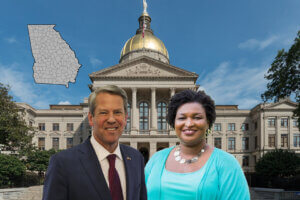West Long Branch, NJ – Donald Trump and Joe Biden remain locked in a tight race for Georgia’s electoral votes according to the Monmouth (“Mon-muth”) University Poll. The overall stability masks shifting gains and losses among a key demographic group. In the two contests for U.S. Senate, the GOP maintains a lead in the regular election, but the special Senate election is now a three-person race. What once looked like a potential runoff between two Republicans could end up being a two-party contest.
Among all registered voters in Georgia, Trump is supported by 47% and Biden is supported by 46%. Another 2% say they will vote for Libertarian Jo Jorgensen and 4% are undecided. These results include 42% who are certain to vote for Trump and 40% who say are certain about Biden. At the other end of the spectrum, 44% say they are not at all likely to vote for the incumbent and 46% say the same for challenger. The race remains tight when different likely voter models are applied. A model based on a higher level of turnout than 2016 puts the race at 48% Trump and 46% Biden while one reflecting lower turnout produces a similar 50% Trump and 45% Biden result. These results are nearly identical to Monmouth’s July poll (see table).
There have been some demographic shifts in support even though the top-line numbers remain basically unchanged. Biden maintains his advantage in 14 swing counties* where the vote margins were closest in the 2016 presidential election. He leads Trump among registered voters in these counties by 54% to 34%, similar to his 58% to 38% lead in July. Both candidates are also holding steady in their base areas: Trump in the counties he won handily four years ago (71% to 25% now versus 68% to 25% in July) and Biden in counties that went solidly for Hillary Clinton in 2016 (70% to 24% now versus 71% to 22% in July).
The poll also finds Trump has gained an advantage among voters age 65 and older – leading Biden by 61% to 36% now, versus trailing slightly by 48% to 52% in July. Biden is stronger, though, among voters age 50 to 64, leading Trump by 54% to 43% versus trailing slightly by 46% to 48% in July. There has also been a small shift among voters under 50 years old, now at 47% Biden to 42% Trump versus an even 46% to 46% split in July.
“There seems to be a tension between shoring up the base and courting swing voters in Georgia. A loss in one demographic group appears to be offset by a gain in another,” said Patrick Murray, director of the independent Monmouth University Polling Institute. Trump won Georgia by five points in 2016.
| GEORGIA: PRESIDENT VOTER MODELS | ||||
| Registered voters | High likely turnout | Low likely turnout | ||
| September | ||||
| Trump | 47% | 48% | 50% | |
| Biden | 46% | 46% | 45% | |
| Jorgensen | 2% | 2% | 1% | |
| Undecided | 4% | 4% | 3% | |
| July | ||||
| Trump | 47% | 48% | 49% | |
| Biden | 47% | 47% | 46% | |
| Jorgensen | 3% | 2% | 2% | |
| Undecided | 3% | 3% | 4% | |
| Source: Monmouth University Poll, Sep. 17-21, 2020 | ||||
– Senate contests –
Republican incumbent David Perdue holds a 48% to 42% lead over Democratic challenger Jon Ossoff in Georgia’s regularly scheduled U.S. Senate election. Libertarian Shane Hazel earns 4% while another 6% are undecided. Likely voter models show similar results under either high turnout (48% Perdue and 43% Ossoff) or low turnout (50% Perdue and 42% Ossoff) scenarios. Looking at coattail effects, Perdue has the support of 91% of Trump voters (92% in July). Ossoff has the backing of 85% of Biden voters (83% in July). Very little has changed in this race since Monmouth’s last poll (see table).
The other senate seat will be decided by a special election, featuring a blanket primary with 20 listed candidates on the November ballot. This is currently a three-way race. Republican Kelly Loeffler, who was appointed to the seat earlier this year, has 23% support, fellow Republican Doug Collins has 22% support and Democrat Raphael Warnock has 21% support. Other candidates named in the poll are Democrats Matt Lieberman (11%) and Ed Tarver (4%) and Libertarian Brian Slowinski (3%).
These results are very similar to Monmouth’s July poll, with one key exception. Warnock’s support has increased by 12 points among registered voters since the summer (from 9% in July) while the number of undecided voters has decreased (from 18% to 13%). Among likely voters in Monmouth’s high turnout scenario, the race is a three-way tie, with 23% each for Loeffler, Collins, and Warnock. There is a statistically insignificant shuffle in the candidate order under a lower turnout scenario at 25% Warnock, 24% Collins, and 23% Loeffler.
| GEORGIA: SENATE VOTER MODELS | ||||
| Regular election | Registered voters | High likely turnout | Low likely turnout | |
| September | ||||
| Perdue (R-i) | 48% | 48% | 50% | |
| Ossoff (D) | 42% | 43% | 42% | |
| Hazel (L) | 4% | 3% | 2% | |
| Undecided | 6% | 5% | 4% | |
| July | ||||
| Perdue (R-i) | 49% | 50% | 51% | |
| Ossoff (D) | 43% | 43% | 43% | |
| Hazel (L) | 1% | 1% | 1% | |
| Undecided | 7% | 6% | 6% | |
| Source: Monmouth University Poll, Sep. 17-21, 2020 | ||||
“Back in the summer, it looked like this seat might be a Republican lock, but Warnock has started to consolidate Democratic voter support. We could see a two-party contest in January after all,” said Murray. A runoff will be held on January 5th if no candidate achieves an outright majority in November.
Among registered voters who back Trump for president, 43% support Loeffler (down from 47% in July) and 43% support Collins (up from 40%). The president has not endorsed a candidate in this race but has made positive remarks about both leading candidates. Among Biden voters, 41% support Warnock (up from 19% in July) while 23% support Lieberman (down from 28%).
A key component of Warnock’s rise has been a shift among Democratic voters. A majority of this group now supports Warnock (52%, up from 26% in July), while there has been a downward movement among Democrats away from both Lieberman (21%, from 32%) and “undecided” (12%, from 22%). Among black voters regardless of party, the race stands at 47% Warnock, 18% Lieberman, 9% Loeffler, 8% Tarver, and 11% undecided. In July, this bloc’s support was 17% Warnock, 24% Lieberman, 14% Loeffler, 7% Tarver, and 28% undecided.
“Warnock has been racking up Democratic endorsements over the past month to emerge as the party’s choice. It’s not clear how much Lieberman has been hurt by the controversy over racial imagery in a novel he published two years ago, but it can’t be helping,” said Murray.
| GEORGIA: SENATE VOTER MODELS | ||||
| Special election | Registered voters | High likely turnout | Low likely turnout | |
| September | ||||
| Loeffler (R-i) | 23% | 23% | 23% | |
| Collins (R) | 22% | 23% | 24% | |
| Warnock (D) | 21% | 23% | 25% | |
| Lieberman (D) | 11% | 11% | 9% | |
| Tarver (D) | 4% | 3% | 2% | |
| Slowinski (L) | 3% | 3% | 2% | |
| Other | 3% | 2% | 2% | |
| Undecided | 13% | 12% | 12% | |
| July | ||||
| Loeffler (R-i) | 26% | 26% | 26% | |
| Collins (R) | 20% | 21% | 22% | |
| Warnock (D) | 9% | 10% | 10% | |
| Lieberman (D) | 14% | 14% | 13% | |
| Tarver (D) | 5% | 5% | 4% | |
| Slowinski (L) | 3% | 2% | 2% | |
| Other | 5% | 4% | 4% | |
| Undecided | 18% | 17% | 19% | |
| Source: Monmouth University Poll, Sep. 17-21, 2020 | ||||
– Other issues –
President Trump continues to earn a split decision from Georgia voters on his handling of the coronavirus outbreak – 49% say he has done a good job and 51% a bad job. Gov. Brian Kemp does slightly better at 52% good job and 46% bad job. Just over half (52%) say they are at least somewhat confident that Trump can put the country on the road to recovery from the pandemic. A similar number (50%) say the same about Biden.
More than one-third of the state’s electorate reside in veteran or military households and these registered voters tend to back Trump (56%) over Biden (36%). A majority (60%) of Georgia voters say that Trump respects our military troops and veterans at least somewhat, but even more (70%) say the same of Biden. This gap flips, though, specifically among voters in military and veteran households – 66% of this group say the incumbent respects the military and 59% say the challenger does.
Overall, 45% of Georgia voters have a favorable opinion of Trump and 46% have an unfavorable one. Biden gets a 43% favorable and 45% unfavorable rating. In July, Trump had a 46% to 45% rating and Biden had a 41% to 46% rating. Similar numbers of voters say either Trump (47%) or Biden (50%) understands the day to day concerns of people like them a great deal or some.
More Republican voters say they are very optimistic about the 2020 presidential election (54%, up from 48% in July) compared with Democrats (29%, identical to 29% in July). However, more Democrats now say they feel more enthusiastic about this contest compared to past elections (62% up from 36%) than Republicans do (52%, up from 47%).
The Monmouth University Poll was conducted by telephone from September 17 to 21, 2020 with 402 Georgia registered voters. The question results in this release have a margin of error of +/- 4.9 percentage points. The poll was conducted by the Monmouth University Polling Institute in West Long Branch, NJ.
* 2016 presidential margin by county groupings:
Swing (21% of turnout) – 14 counties where the winning margin for either candidate was less than 10 points, with a cumulative vote of 49.6% Clinton and 46.0% Trump.
Clinton (34% of turnout) – 22 counties Clinton won by more than 10 points, with a cumulative vote of 68.8% to 27.7%.
Trump (45% of turnout) – 123 counties Trump won by more than 10 points, with a cumulative vote of 70.1% to 26.6%.
QUESTIONS AND RESULTS
(* Some columns may not add to 100% due to rounding.)
1.If the election for President was today, would you vote for … Donald Trump the Republican, Joe Biden the Democrat, or Jo Jorgensen the Libertarian? [NAMES WERE ROTATED] [If UNDECIDED: If you had to vote for one of the following candidates at this moment, who do you lean toward – Donald Trump or Joe Biden?]
| TREND: REGISTERED VOTERS (with leaners) | Sept. 2020 | July 2020 |
| Donald Trump | 47% | 47% |
| Joe Biden | 46% | 47% |
| Jo Jorgensen | 2% | 3% |
| (VOL) Other candidate | 0% | <1% |
| (VOL) No one | <1% | 0% |
| (VOL) Undecided | 4% | 3% |
| (n) | (402) | (402) |
[1A. If Trump/Biden voter, ASK: Are you certain about your vote choice, or might you change your mind before election day?]
[QUESTIONS 2 & 3 WERE ROTATED]
2.What is the likelihood that you might vote for Donald Trump in November – very likely, somewhat likely, not too likely, or not at all likely?
| TREND: REGISTERED VOTERS | Sept. 2020 | July 2020 |
| Certain for Trump (from Q1/A) | 42% | 42% |
| Very likely | 2% | 1% |
| Somewhat likely | 6% | 7% |
| Not too likely | 3% | 4% |
| Not at all likely | 44% | 45% |
| (VOL) Don’t know | 3% | 2% |
| (n) | (402) | (402) |
3.What is the likelihood that you might vote for Joe Biden in November – very likely, somewhat likely, not too likely, or not at all likely?
| TREND: REGISTERED VOTERS | Sept. 2020 | July 2020 |
| Certain for Biden (from Q1/A) | 40% | 39% |
| Very likely | 3% | 3% |
| Somewhat likely | 7% | 9% |
| Not too likely | 1% | 4% |
| Not at all likely | 46% | 44% |
| (VOL) Don’t know | 3% | 2% |
| (n) | (402) | (402) |
As you may know, there are two Senate seats on the ballot this November.
4.In the regularly scheduled race, if the election for U.S. Senate was today, would you vote for … David Perdue the Republican, Jon Ossoff the Democrat, or Shane Hazel the Libertarian? [NAMES WERE ROTATED] [If UNDECIDED: If you had to vote for one of the following candidates at this moment, who do you lean toward – David Perdue or Jon Ossoff?]
| TREND: REGISTERED VOTERS (with leaners) | Sept. 2020 | July 2020 |
| David Perdue | 48% | 49% |
| Jon Ossoff | 42% | 43% |
| Shane Hazel | 4% | 1% |
| (VOL) Other | <1% | 0% |
| (VOL) No one | <1% | <1% |
| (VOL) Undecided | 6% | 7% |
| (n) | (402) | (402) |
5.The other U.S. Senate race is a special election where all the candidates run on the same ballot. If that election was today, would you vote for … Republican Kelly Loeffler, Republican Doug Collins, Democrat Raphael Warnock, Democrat Matt Lieberman, Democrat Ed Tarver, Libertarian Brian Slowinski, or another candidate? [NAMES WERE ROTATED] [If UNDECIDED: If you had to vote for one of the following candidates at this moment, who do you lean toward –Loeffler, Collins, Warnock, Lieberman, or Tarver?]
| TREND: REGISTERED VOTERS (with leaners) | Sept. 2020 | July 2020 |
| Kelly Loeffler (R) | 23% | 26% |
| Doug Collins (R) | 22% | 20% |
| Raphael Warnock (D) | 21% | 9% |
| Matt Lieberman (D) | 11% | 14% |
| Ed Tarver (D) | 4% | 5% |
| Brian Slowinski (L) | 3% | 3% |
| Other candidate | 3% | 5% |
| (VOL) No one | <1% | 0% |
| (VOL) Undecided | 13% | 18% |
| (n) | (402) | (402) |
[QUESTIONS 6 & 7 WERE ROTATED]
6.Is your general impression of Donald Trump very favorable, somewhat favorable, somewhat unfavorable, or very unfavorable, or do you have no opinion?
| TREND: REGISTERED VOTERS | Sept. 2020 | July 2020 |
| Very favorable | 32% | 28% |
| Somewhat favorable | 13% | 18% |
| Somewhat unfavorable | 7% | 7% |
| Very unfavorable | 39% | 38% |
| No opinion | 8% | 10% |
| (n) | (402) | (402) |
7.Is your general impression of Joe Biden very favorable, somewhat favorable, somewhat unfavorable, or very unfavorable, or do you have no opinion?
| TREND: REGISTERED VOTERS | Sept. 2020 | July 2020 |
| Very favorable | 24% | 21% |
| Somewhat favorable | 19% | 20% |
| Somewhat unfavorable | 7% | 12% |
| Very unfavorable | 38% | 34% |
| No opinion | 11% | 12% |
| (n) | (402) | (402) |
[QUESTIONS 8 & 9 WERE ROTATED]
8.How much does Donald Trump understand the day to day concerns of people like you – a great deal, some, not much, or not at all?
| REGISTERED VOTERS | Sept. 2020 |
| Great deal | 32% |
| Some | 15% |
| Not much | 14% |
| Not at all | 37% |
| (VOL) Don’t know | 2% |
| (n) | (402) |
9.How much does Joe Biden understand the day to day concerns of people like you – a great deal, some, not much, or not at all?
| REGISTERED VOTERS | Sept. 2020 |
| Great deal | 26% |
| Some | 24% |
| Not much | 13% |
| Not at all | 35% |
| (VOL) Don’t know | 2% |
| (n) | (402) |
10.Do you feel optimistic or pessimistic about the 2020 presidential election? [Is that very or somewhat optimistic/pessimistic]?
| TREND: REGISTERED VOTERS | Sept. 2020 | July 2020 |
| Very optimistic | 32% | 35% |
| Somewhat optimistic | 35% | 31% |
| Somewhat pessimistic | 15% | 15% |
| Very pessimistic | 14% | 11% |
| (VOL) Neither, don’t care | 2% | 5% |
| (VOL) Don’t know | 3% | 4% |
| (n) | (402) | (402) |
11.How motivated are you to vote in the November election for president – very motivated, somewhat motivated, or not that motivated?
| TREND: REGISTERED VOTERS | Sept. 2020 | July 2020 |
| Very motivated | 90% | 83% |
| Somewhat motivated | 8% | 12% |
| Not that motivated | 2% | 5% |
| (VOL) Don’t know | 0% | 0% |
| (n) | (402) | (402) |
12.Compared to past elections, are you more enthusiastic than usual, less enthusiastic, or about the same as past elections?
| TREND: REGISTERED VOTERS | Sept. 2020 | July 2020 |
| More enthusiastic | 49% | 38% |
| Less enthusiastic | 14% | 15% |
| About the same | 37% | 46% |
| (VOL) Don’t know | 0% | 1% |
| (n) | (402) | (402) |
[QUESTIONS 13 & 14 WERE ROTATED]
13.Has Donald Trump done a good job or bad job handling the coronavirus outbreak? [Is that very or somewhat good/bad?]
| TREND: REGISTERED VOTERS | Sept. 2020 | July 2020 |
| Very good | 33% | 31% |
| Somewhat good | 16% | 17% |
| Somewhat bad | 7% | 10% |
| Very bad | 44% | 41% |
| (VOL) Don’t know | 1% | 1% |
| (n) | (402) | (402) |
14.Has Governor Brian Kemp done a good job or bad job handling the coronavirus outbreak? [Is that very or somewhat good/bad?]
| TREND: REGISTERED VOTERS | Sept. 2020 | July 2020 |
| Very good | 30% | 29% |
| Somewhat good | 22% | 25% |
| Somewhat bad | 14% | 15% |
| Very bad | 32% | 30% |
| (VOL) Don’t know | 3% | 2% |
| (n) | (402) | (402) |
[QUESTIONS 15 & 16 WERE ROTATED]
15.How confident are you that Donald Trump can put the country on the road to recovery from the pandemic – very confident, somewhat confident, not too confident, or not at all confident?
| REGISTERED VOTERS | Sept. 2020 |
| Very confident | 38% |
| Somewhat confident | 14% |
| Not too confident | 7% |
| Not at all confident | 39% |
| (VOL) Don’t know | 1% |
| (n) | (402) |
16.How confident are you that Joe Biden can put the country on the road to recovery from the pandemic – very confident, somewhat confident, not too confident, or not at all confident?
| REGISTERED VOTERS | Sept. 2020 |
| Very confident | 22% |
| Somewhat confident | 28% |
| Not too confident | 7% |
| Not at all confident | 41% |
| (VOL) Don’t know | 1% |
| (n) | (402) |
[QUESTIONS 17 & 18 WERE ROTATED]
17.Would you say Donald Trump respects our military troops and veterans a great deal, some, not much, or not at all?
| REGISTERED VOTERS | Sept. 2020 |
| Great deal | 44% |
| Some | 16% |
| Not much | 10% |
| Not at all | 28% |
| (VOL) Don’t know | 2% |
| (n) | (402) |
18.Would you say Joe Biden respects our military troops and veterans a great deal, some, not much, or not at all?
| REGISTERED VOTERS | Sept. 2020 |
| Great deal | 44% |
| Some | 26% |
| Not much | 11% |
| Not at all | 16% |
| (VOL) Don’t know | 4% |
| (n) | (402) |
METHODOLOGY
The Monmouth University Poll was sponsored and conducted by the Monmouth University Polling Institute from September 17 to 21, 2020 with a statewide random sample of 402 Georgia voters drawn from a list of registered voters. This includes 136 contacted by a live interviewer on a landline telephone and 266 contacted by a live interviewer on a cell phone, in English. Monmouth is responsible for all aspects of the survey design, data weighting and analysis. The full sample is weighted for party primary vote history, age, gender, race, education, and region based on state voter registration list information and U.S. Census information (CPS 2018 supplement). Data collection support provided by Braun Research (field) and Aristotle (voter sample). For results based on the full voter sample, one can say with 95% confidence that the error attributable to sampling has a maximum margin of plus or minus 4.9 percentage points (unadjusted for sample design). Sampling error can be larger for sub-groups (see table below). In addition to sampling error, one should bear in mind that question wording and practical difficulties in conducting surveys can introduce error or bias into the findings of opinion polls.
| DEMOGRAPHICS (weighted) |
| REGISTERED VOTERS |
| Party primary history |
| 37% Republican |
| 28% Other/none |
| 34% Democrat |
| Self-Reported Party |
| 36% Republican |
| 36% Independent |
| 29% Democrat |
| 46% Male |
| 54% Female |
| 25% 18-34 |
| 25% 35-49 |
| 27% 50-64 |
| 23% 65+ |
| 62% White, non-Hispanic |
| 31% Black |
| 4% Hispanic |
| 3% Asian |
| 1% Other race |
| 66% No degree |
| 34% 4 year degree |
Click on pdf file link below for full methodology and crosstabs by key demographic groups.




